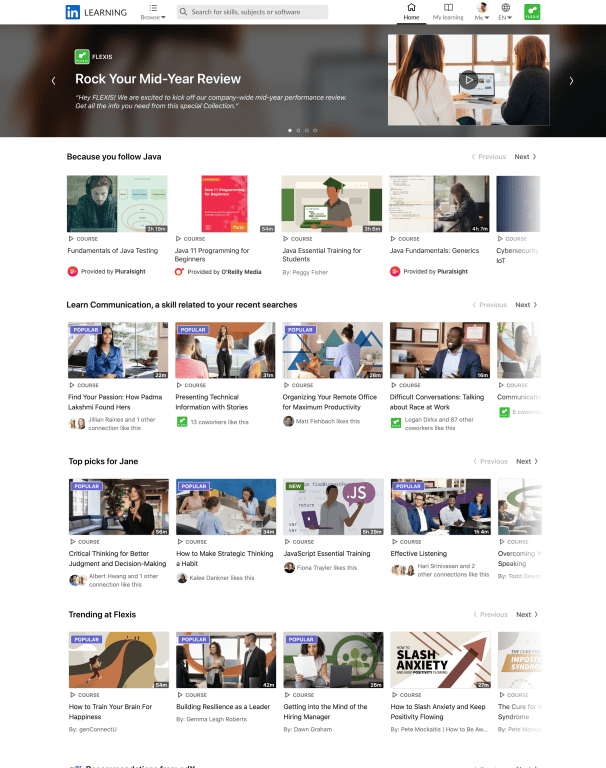LinkedIn on the need for personalized, collaborative learning
It aims to do this through its newly launch LXP, LinkedIn Learning Hub.
Why You Should Care
The ongoing disruption of the world of work has placed a spotlight on the need to prioritize learning and development.
To support companies in the 'great reshuffle', LinkedIn has launched a new learning experience platform (LXP).
UNLEASH spoke to LinkedIn's Becky Schnauffer about the new LXP and how it helps to personalize learning.
The COVID-19 pandemic has transformed the world of work forever. However, disruption to how we work is far from over.
In fact, according to professional networking platform LinkedIn, we are in the middle of a ‘great reshuffle’. There is an unprecedented amount of change affecting companies and individuals as they reflect on the past 18 months and look forward to the future of work.
LinkedIn’s research has found that 72% of leaders see training as crucial to employees succeeding in the flexible and hybrid working environments of the future.
This is particularly urgent as another study by LinkedIn found that younger employees (69%) felt their professional development has been stunted by the impact, primarily because they struggled to learn by ‘osmosis’ from their peers or managers.
In light of the fact that “learning and development was front and center, and was going to become even more [important] from a business strategy perspective”, LinkedIn decided to bring all of its existing learning offerings under one roof in a learning experience platform (LXP) called LinkedIn Learning Hub, according to the company’s talent solutions’ UKI senior director Becky Schnauffer.
Schnauffer tells UNLEASH the newly launched LXP really takes LinkedIn’s existing approach to learning – by providing courses and steaming content on the likes of unconscious bias, diversity, inclusion and belonging and the Microsoft Office suite – to the next level.
“It was about pulling everything together to talk to the needs of our clients”, she explains.

Becky Schnauffer, senior director of LinkedIn Talent Solution for UKI.
Personalized learning is a must
According to Schnauffer, the hub relies on “data, analysis and AI to build out a tailored, personal approach to learning” for employees.
To do this, it leverages “not only the content we have in house, but also the content the customer is bringing in”. They are then really able to “stream that to their employees in whatever way they want”, Schnauffer explains.
She emphasizes that LinkedIn Learning Hub is “not a closed or proprietary system in terms of technology”.
“It is an open system for the very reason that people have the opportunity to build out that learning content and those learning journeys that will fully develop their organization.”
The data and analytics element of LinkedIn Learning Hub really differentiates it from other products on the market.
“We can use AI to help companies make learning decisions for their employees in a way that nobody else can,” notes Schnauffer. LinkedIn does this with the help of its skills graph taxonomy offering, which is linked to its professional networking social media platform.
Schnauffer adds: “There are lots of skills in demand today that weren’t yesterday”.
But LinkedIn Learning Hub aims to help companies not only make sure they have the right skills for today, but also “look at where the market is going and what skills they are going to need tomorrow”.
This means they are being proactive and planning for the future. She calls on employers to “actually plan for the future [by] developing and investing in your employees to enable to develop those skills that your organization is going to need in the future”.
Otherwise, employers will have to spend a lot of money down the line on sourcing, hiring, and onboarding new employees with those potentially scarce skills.

Community-based learning is the future
Another central element of LinkedIn’s new LXP is it encourages community-based learning, despite people learning on their own and using digital platforms.
It is no surprise that the community and networking element of learning is crucial to LinkedIn, its vision is “connecting every member of the global workforce with opportunities”, according to Schnauffer.
The LinkedIn Learning Hub enables learners to stay connected with their colleagues, peers, and sector matter experts while learning. This is crucial as LinkedIn’s data shows that companies using its learning hub’s social features spent 30 times longer learning than those that don’t.
“That is a really good affirmation of community learning is so important, especially if, as an organization, you’re trying to get more people to jump on the learning bandwagon,” notes Schnauffer.
In addition, the LXP’s reliance on data and analytics means it can track what people are learning and then recommendations of what they should learn next.
These recommendations are based on what people’s peers have been learning and mean that employees might end up doing courses they wouldn’t previously think to do. This is ultimately good for upskilling and ensuring employees’ skills are competitive in the future of work.
Although the LinkedIn Learning Hub has only just launched, Schauffer is clear that it is not a static platform, like the wider professional networking site.
Thinking generally about LinkedIn, Schnauffer concludes: “We evolve in line with the market and with our users. Nothing we do is static, everything is very much moving forward and it is going to be the same with the learning hub”.
Sign up to the UNLEASH Newsletter
Get the Editor’s picks of the week delivered straight to your inbox!

Chief Reporter
Allie is an award-winning business journalist and can be reached at alexandra@unleash.ai.
